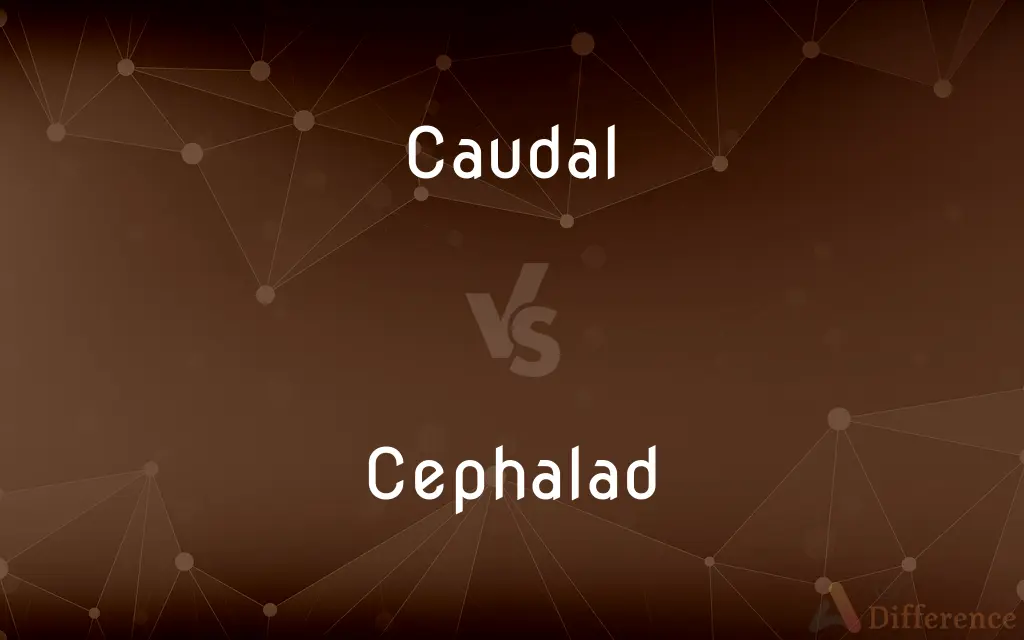Caudal vs. Cephalad — What's the Difference?
By Tayyaba Rehman & Maham Liaqat — Updated on March 27, 2024
Caudal refers to a direction towards the tail or posterior end of the body, while cephalad points towards the head or anterior end. Each term is used to describe anatomical directions in a body.

Difference Between Caudal and Cephalad
Table of Contents
ADVERTISEMENT
Key Differences
Caudal directionality signifies a position towards the lower end of the body or closer to the tail in animals, including humans, where it implies a direction towards the feet or away from the head. On the other hand, cephalad (or cephalic) orientation means moving towards the head or the upper part of the body, used to indicate anatomical positions or movements that are closer to the head relative to another point of reference.
In the context of human anatomy, the caudal direction is used to describe body parts or areas that are nearer to the feet than another referenced part, aiding in the precise description of location or direction of procedures. Whereas cephalad direction is utilized to describe parts that are closer to the head, essential in surgeries and medical imaging to ensure clarity in communication among healthcare professionals.
The caudal approach in medical treatments or diagnoses might focus on the lower extremities or lower spinal regions, guiding interventions that target the lower back, pelvis, and legs. Conversely, cephalad approaches are often concerned with treatments or assessments of the head, neck, and upper thoracic regions, guiding therapeutic and diagnostic procedures in these areas.
In embryology, caudal references help in identifying developmental stages and structures towards the posterior end of an embryo, crucial for understanding the morphogenesis and development of the tail end and lower body structures. In contrast, cephalad references are key to studying the development of the head, brain, and upper body structures, highlighting the importance of directionality in embryonic development.
The use of caudal and cephalad terms extends beyond medical and biological contexts, applying to the comparative anatomy of various organisms to describe evolutionary adaptations and functions related to their body orientation. Cephalad adaptations often relate to sensory, feeding, and brain development, reflecting the evolutionary significance of head-oriented features.
ADVERTISEMENT
Comparison Chart
Directionality
Towards the tail/posterior
Towards the head/anterior
Reference in Anatomy
Lower body parts, closer to feet
Upper body parts, closer to head
Medical Applications
Lower back, pelvis, legs
Head, neck, upper thorax
Embryological Focus
Development of tail, lower body
Development of head, upper body
Evolutionary Significance
Adaptations for locomotion, stability
Adaptations for sensory, feeding, brain development
Compare with Definitions
Caudal
Relating to the tailbone or coccyx.
Caudal epidurals are administered in the lower back.
Cephalad
Relating to the head or towards the head.
Cephalad movement is essential in cranial surgery.
Caudal
Pertaining to the tail end of the body.
The caudal fin of a fish provides propulsion.
Cephalad
Used in medicine to describe movement towards the upper body.
The medication was injected cephalad to the site of injury.
Caudal
In a position posterior to another.
The pelvis is caudal to the abdomen.
Cephalad
Pertaining to the cranial region or skull.
Cephalad development in embryos highlights brain growth.
Caudal
Used to describe the back of a structure.
The caudal edge of the liver is oriented towards the back.
Cephalad
Referring to the anterior part of the body.
The cephalad portion of the spinal column is the cervical spine.
Caudal
Directed towards the lower body region.
The surgeon made a caudal incision below the waist.
Cephalad
Involving the direction or orientation towards the head.
The cephalad direction was chosen for the surgical approach.
Caudal
Of, at, or near the tail or hind parts; posterior
The caudal fin of a fish.
Cephalad
Toward the head or anterior section.
Caudal
Situated beneath or on the underside; inferior.
Cephalad
(anatomy) Towards the head (or anterior extremity), a direction that in humans corresponds to superior.
Caudal
Similar to a tail in form or function.
Cephalad
Forwards; towards the head or anterior extremity of the body; opposed to caudad.
Caudal
(zoology) Pertaining to the tail or posterior or hind part of a body.
Caudal
Toward the tail end (hind end) of the body; in bipeds such as humans, this direction corresponds to inferior.
Caudal
A caudal vertebra.
Caudal
Of the nature of, or pertaining to, a tail; having a tail-like appendage.
The male widow-bird, remarkable for his caudal plumes.
Caudal
Constituting or relating to a tail;
Caudal appendage
Caudal
Resembling a tail
Caudal
(of quadrupeds) situated in or directed toward the part of the body from which the tail arises;
Caudal fins
The caudal end of the body
Caudal
Toward the posterior end of the body
Common Curiosities
Can caudal and cephalad be used interchangeably with other directional terms?
No, they have specific meanings related to the direction towards the tail (caudal) or head (cephalad) and are not interchangeable with terms like dorsal (back) or ventral (front).
What is cephalad orientation?
Cephalad orientation means positioning or moving towards the head or anterior part of the body.
What does caudal mean?
Caudal refers to a position or direction towards the tail or posterior end of the body.
How are caudal and cephalad used in anatomy?
They are used to describe anatomical directions: caudal for locations closer to the lower body or tail, and cephalad for locations nearer to the head.
Why are caudal and cephalad important in medical procedures?
They provide precise language for describing the location of surgical interventions or diagnoses, ensuring clear communication among healthcare professionals.
Are caudal and cephalad terms used in describing all animals?
Yes, these terms are applicable across a wide range of animals for describing anatomical directions.
How do caudal and cephalad relate to evolutionary biology?
They help in understanding evolutionary adaptations related to body orientation, such as sensory and locomotion improvements.
What is a caudal injection?
A caudal injection is a medical procedure where medication is administered into the lower back, near the tailbone or coccyx.
Can caudal refer to any part of the body?
It specifically refers to parts of the body that are closer to the tail or posterior end, not just any part.
What is the significance of cephalad direction in embryology?
It is crucial for studying the development of the head, brain, and upper body structures in embryos.
Do caudal and cephalad have applications outside of medicine?
Yes, they are also used in biology and embryology to describe the orientation and development of organisms and embryos.
How does caudal orientation affect treatment approaches?
Caudal orientation influences treatments targeting the lower back, pelvis, and legs, guiding the approach and techniques used.
Is cephalad direction always upwards?
In the context of an organism's anatomy, cephalad direction is towards the head, which is typically upwards in bipeds but varies in other organisms.
How does cephalad development differ from caudal in embryos?
Cephalad development focuses on the head and upper body, while caudal development concentrates on the tail end and lower body.
Are there specific surgeries that require a cephalad approach?
Yes, surgeries involving the head, neck, and upper thoracic regions often require a cephalad approach for precision and safety.
Share Your Discovery

Previous Comparison
Anything vs. Anythink
Next Comparison
Benzodiazepine vs. ZolpidemAuthor Spotlight
Written by
Tayyaba RehmanTayyaba Rehman is a distinguished writer, currently serving as a primary contributor to askdifference.com. As a researcher in semantics and etymology, Tayyaba's passion for the complexity of languages and their distinctions has found a perfect home on the platform. Tayyaba delves into the intricacies of language, distinguishing between commonly confused words and phrases, thereby providing clarity for readers worldwide.
Co-written by
Maham Liaqat














































